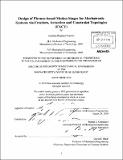| dc.contributor.advisor | Martin L. Culpepper. | en_US |
| dc.contributor.author | Hopkins, Jonathan B. (Jonathan Brigham) | en_US |
| dc.contributor.other | Massachusetts Institute of Technology. Dept. of Mechanical Engineering. | en_US |
| dc.date.accessioned | 2011-04-25T16:11:14Z | |
| dc.date.available | 2011-04-25T16:11:14Z | |
| dc.date.copyright | 2010 | en_US |
| dc.date.issued | 2010 | en_US |
| dc.identifier.uri | http://hdl.handle.net/1721.1/62511 | |
| dc.description | Thesis (Ph. D.)--Massachusetts Institute of Technology, Dept. of Mechanical Engineering, 2010. | en_US |
| dc.description | Cataloged from PDF version of thesis. | en_US |
| dc.description | Includes bibliographical references (p. 191-195). | en_US |
| dc.description.abstract | The aim of this thesis is to generate the knowledge required to (i) synthesize serial flexure systems and (ii) optimally place actuators using a comprehensive library of geometric shapes called freedom, actuation, and constraint spaces. These geometric shapes guide designers through the creative process of concept generation without compromising engineering rigor. Each shape rapidly conveys the mathematics of screw theory, projective geometry, and constraint-based design by visually depicting regions where constraints and actuators may be placed for synthesizing optimal flexure concepts. In this way, designers may consider every flexure concept that satisfies the desired functional requirements before selecting the final design. FACT was created to improve the design processes for small-scale flexure systems and precision machines. For instance, there is a need to create multi-axis nanopositioners for emerging three-dimensional nano-scale research/manufacturing. Through this work the following contributions were made: (1) the fifty freedom and constraint space types were found that may be used to synthesize both parallel and serial flexure concepts, (2) intermediate freedom spaces were created that help designers stack conjugated flexure elements to avoid or utilize underconstraint, (3) a twist-wrench stiffness matrix was created to model the elastomechanic behavior of flexure systems, (4) the twenty-six actuation spaces were found that help guide designers in placing actuators that minimize motion errors, and (5) a theory was created that determines the force and displacement actuator outputs for accessing a desired DOF once actuators have been placed. A serially conjugated lead screw flexure was designed using the FACT design process and a parallel flexure system was built to validate the theory of actuation described in this thesis. | en_US |
| dc.description.statementofresponsibility | by Jonathan Brigham Hopkins. | en_US |
| dc.format.extent | 195 p. | en_US |
| dc.language.iso | eng | en_US |
| dc.publisher | Massachusetts Institute of Technology | en_US |
| dc.rights | M.I.T. theses are protected by
copyright. They may be viewed from this source for any purpose, but
reproduction or distribution in any format is prohibited without written
permission. See provided URL for inquiries about permission. | en_US |
| dc.rights.uri | http://dspace.mit.edu/handle/1721.1/7582 | en_US |
| dc.subject | Mechanical Engineering. | en_US |
| dc.title | Design of flexure-based motion stages for mechatronic systems via Freedom, Actuation and Constraint Topologies (FACT) | en_US |
| dc.title.alternative | Design of flexure-based motion stages for mechatronic systems via FACT | en_US |
| dc.type | Thesis | en_US |
| dc.description.degree | Ph.D. | en_US |
| dc.contributor.department | Massachusetts Institute of Technology. Department of Mechanical Engineering | |
| dc.identifier.oclc | 712602238 | en_US |
